Several Roman historians tell stories of Gauls fighting in the nude. ((Plb. 2.28.8, Diod. 5.30.3, and Liv. 38.21.)) The Dying Gaul on display at the National Gallery of Art corroborates their tales or at least that they believed them. Regardless, it is a remarkable display of Roman appreciation for Hellenistic art.
Here is my appreciation.
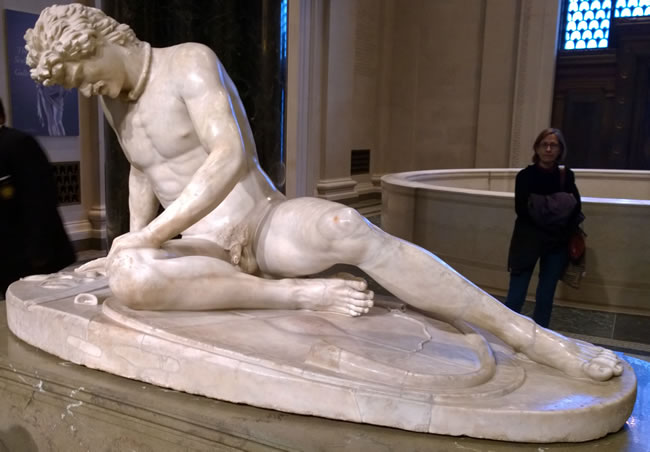
At first glance, the Dying Gaul is immediately impressive, depressing, and overwhelming. It frankly puts most modern-day war monuments to shame, even the more dramatic ones. However, it is the age and content that captures the imagination.
I have seen thousands of war monuments strewn across battlefields in America, Europe, and Asia. While many of these are remarkable works, the oldest dates back to the seventeenth-century. Conversely, this copy of the Dying Gaul dates back to the second-century AD. What’s more, the Hellenistic original was made in the third-century BC, now lost to history. It is remarkable to consider that a Civil War or world war monument may have a lifespan of thousands of years.
Also consider for a moment that this monument depicts not the victorious Attalids who commissioned the piece, but the defeated Gauls. Yet the depiction remains that of a noble, sympathetic death. The makers clearly sought to commemorate their vanquished foes. It is difficult to envision the United States building a monument to a German, Japanese, Korean, or Iraqi soldier.
Then there is the rich history of the monument.
What the hell am I looking at?
Glad you asked. The context of the Dying Gaul illuminates a gap in popular history. When Alexander the Great (r. 336-323 BC) conquered the Persian Empire, he mixed European and Asian cultures into what we now refer to as the Hellenistic World.
Along with an interesting blend of philosophy, poetry, and religion, came magnificent art.
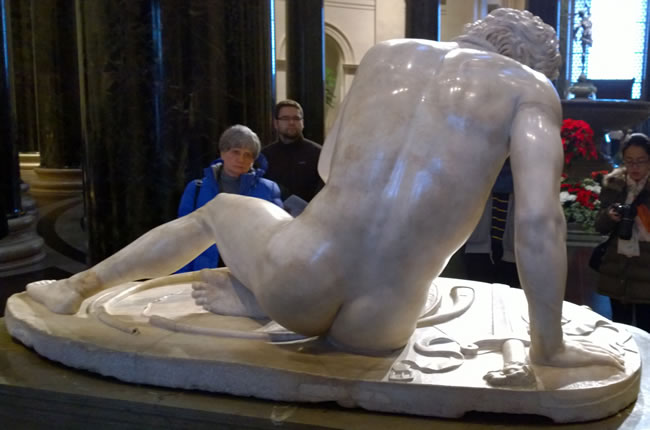
Unfortunately, your eyes tend to glaze over if you are unfamiliar with any of the following names. The layman version is that 100 years after the death of Alexander, remnants of one of his general’s kingdoms still occupied a portion of modern-day Turkey. After fending off some invading Gauls, they built this monument to commemorate the occasion one to two decades later, between 230 and 220 BC.
More specifically, after the Attalids defeated the Gauls in 241 BC, King Attalus I (r. 241-197 BC) commissioned a monument to commemorate the victory. The result is what we now call the Dying Gaul. Today, we only have a Roman copy of the original, crafted sometime in the second century AD. ((This is the most commonly agreed upon origin. However, some believe the Hellenistic original was made as late as 210 BC. See Seymour Howard, “The Dying Gaul, Aigina Warriors, and Pergamene Academicism,” American Journal of Archaeology 87, no 4 (1983): 483-487.))
The delay between the victory (241 BC) and the building of the monument (230-220 BC) is worth noting. There was also a two-decade period before Americans began to reflect on the Civil War en masse. In the 1880s, veterans and survivors remembered the war through public commemorations, memoirs, and of course, monuments.
Concrete Proof?
The monument provides corroboration to ancient accounts that the Gauls fought in the nude, or at least that ancient historians and artists believed they fought in the nude.
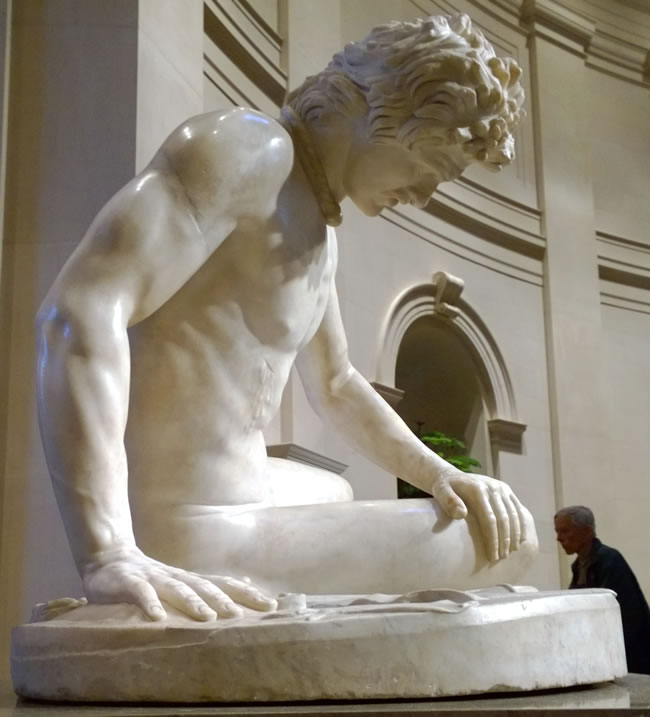
Polybius (c. 200-118 BC), the historian closest to the events, wrote about the Gauls, describing them at one battle as having
discarded these garments owing to their proud confidence in themselves, and stood naked, with nothing but their arms, in front of the whole army, thinking that thus they would be more efficient, as some of the ground was overgrown with brambles which would catch in their clothes and impede the use of their weapons (Plb. 2.28.8). ((This translation comes from the W. R. Paton translation. The Histories of Polybius, trans. W. R. Paton, 6 vols. (Cambridge: Harvard University Press, 1922-1927).))
Writing a century later, Diodorus also talked about the Gauls, some of whom fought in armor while “others are satisfied with the armour which Nature has given them and go into battle naked” (Diod. 5.30.3). ((This translation comes from the C. H. Oldfather translation. Diodorus Siculus, The Library of History, trans. C. H. Oldfather, 12 vols. (Cambridge: Harvard University Press, 1933-1967).))
Finally, Livy (59 BC – 17 AD) noted the paleness of the Gauls’s skin, as they fought in the nude, but otherwise remained clothed in all other activities.
The fact that they fight naked makes their wounds conspicuous and their bodies are fleshy and white, as is natural, since they are never uncovered except in battle; so that both more blood flowed from their abundant flesh and the wounds stood out to view more fearfully and the whiteness of their skins was more stained by the black blood (Liv. 38.21.9). ((This translation comes from the William Heinemann translation.))
Livy’s point about how their wounds stood out “more fearfully” is interesting when we consider that the Romans painted all their sculptures in the most gaudy fashion. Even polished and without paint, there is a clearly visible stab wound complete with dripping blood.
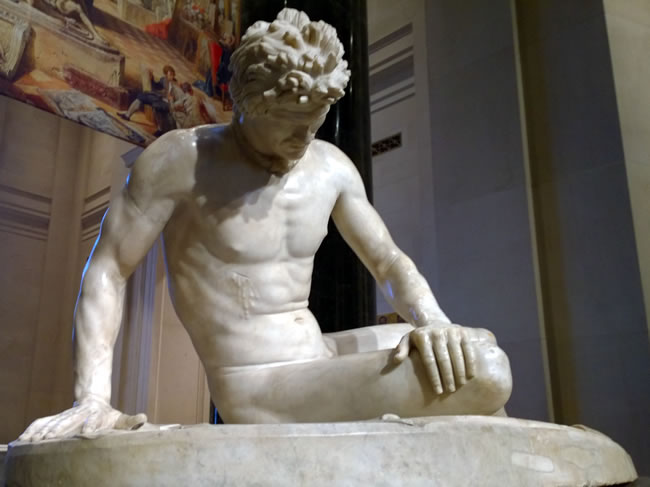
The following provides a side view and a front view.
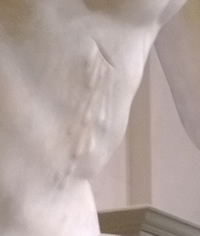
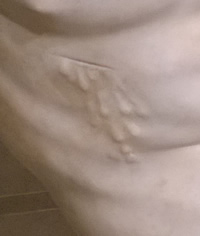
The Dying Gaul also displays a trumpet at the base. Again, Diodorus tell us “their trumpets are of peculiar nature and such as barbarians use, for when they are blown upon they give forth a harsh sound, appropriate to the tumult of war” (Diod. 5.30.3).
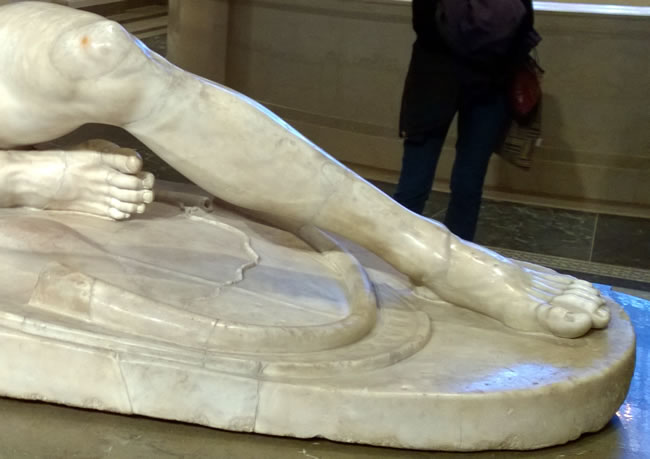
If you are into 1800-year-old Roman copies of Hellenistic art, then you must make it out to the National Gallery of Art between now and March 16 to see the Dying Gaul.
Next, we will look at some of the restoration work performed on the statue after its excavation in the 1600s.
